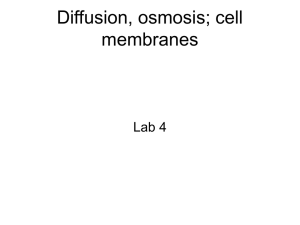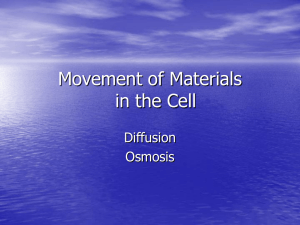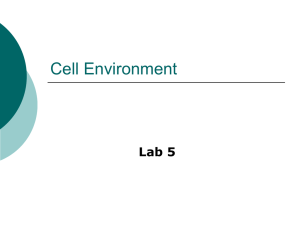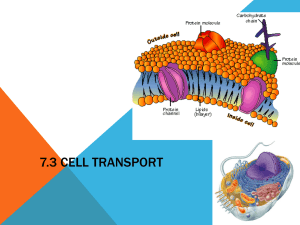Diffusion and Osmosis Worksheet with Answers
advertisement
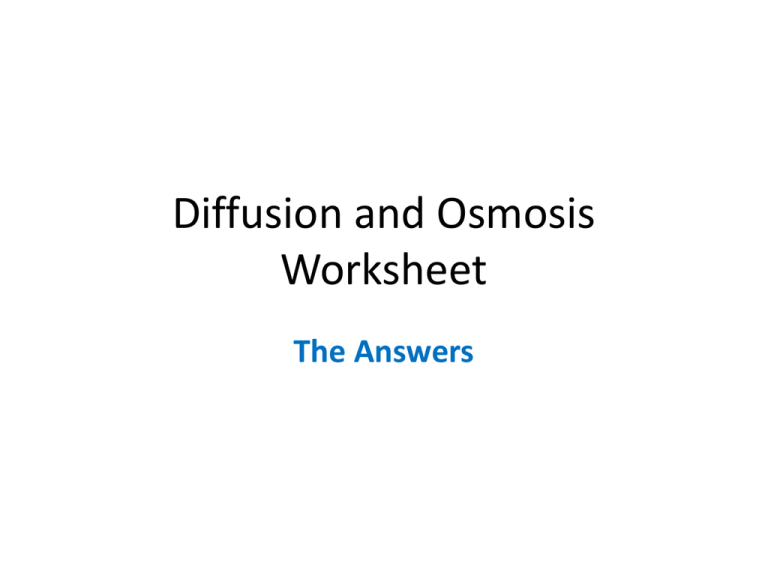
Diffusion and Osmosis Worksheet The Answers 1a. These are pictures of molecules frozen at two different times. Draw arrows to show the direction each particle might travel due to diffusion in diagrams A and B. 1a. These are pictures of molecules frozen at two different times. Draw arrows to show the direction each particle might travel due to diffusion in diagrams A and B. 1b. Describe the way the particles of a gas move. Randomly. They continue in a straight line until they hit each other or an object and ricochet in a new direction. 1a. These are pictures of molecules frozen at two different times. Draw arrows to show the direction each particle might travel due to diffusion in diagrams A and B. 1c. Diagram A shows the same number of particles as in Diagram B except most particles start out on one side of the box. Explain why after a while, Diagram A resembles Diagram B. . Molecules move randomly until they reach equillibrium. 2. Give an everyday example of diffusion in air and in water. AIR: Scents, Smells WATER: Food coloring in glass of water 3. Complete the following sentence: RANDOM Diffusion is the ___________ HIGH movement of particles from ______ concentration to LOW a _______ concentration until they are __________ spread out. EVENLY 4. Moths emit chemicals called pheromones to attract a mate. a) Which process is responsible for the distribution of these chemicals through the air? DIFFUSION b) If a moth detects pheromones, how might it work out which direction they are coming from? Detect the higher concentration of pheromones. c) What would be the advantage of a moth releasing the pheromones on a night when there was little wind? The pheromones are not blown away from a potential mate. Osmosis is the diffusion of water across a semi permeable membrane. The semi permeable membrane acts like a filter that lets only the water through. Water always goes from the area of higher water concentration to the area of lower water concentration. Confused? Then imagine the particles (or solute) are salt and follow the rule - SALT SUCKS! 5a. On the diagram on the next page label the: • Semi permeable membrane (M) • Area of higher water concentration (HC) • Area of lower water concentration (LC) • Direction of osmotic flow (arrow) M LC HC 5b. What happens to the number of water particles on the left hand side? They will increase. What happens to the concentration of the solution on the right hand side? They will stay the same. What happens to the concentration of the solution on the left hand side? It will decrease. Explain why the concentrations of solution on either side of the semi-permeable membrane change? Water passes through the membrane until in equilibrium. The salt does not. 6. Complete the following sentence: WATER Osmosis is the passage of _______ LOW molecules from a _______ concentrated HIGH solution to a _________ concentrated solution through a SEMI PERMEABLE MEMBRANE ________________________ 7. The roots of a plant have root hair cells that absorb water from the soil. The diagram below shows two different kinds of roots. The concentration of the solution inside the cell is higher than the concentration of the solution in the soil. a) Explain why water moves from the soil into the root hair cell. Water equilibrates through the semi permeable membrane moving from a high concentration of H2O outside to a low concentration of H2O inside the cell. b) Suggest why root hair cells are long and thin and not short and stubby? More membrane surface area so more water can be taken up by the plant. 8. Label the following diagrams of Red Blood Cells and Plant Cells as being examples of cells contained in Isotonic, Hypertonic and Hypotonic solutions. HYPO ISOTONIC HYPER 9. Strawberry jelly is a very strong solution of sugar. By contrast the cytoplasm in a bacteria is a Much weaker solution. (a.) The cell wall of a microbe is made up of a semi-permeable membrane. Would water flow from the microbe to the jam, or from the jam to the microbe by osmosis? It would flow from the microbe to the jam. (b.) Explain why bacteria find it difficult to survive in jam. They can’t keep water inside of their cell which they need for their metabolism.


